Key takeaways:
- Festival photography captures the electric atmosphere and individual stories, requiring a personal connection to effectively convey emotions.
- Essential gear includes a versatile camera with good low-light performance and fast lenses to adapt to varying lighting conditions.
- Mastering techniques like shooting from different angles and utilizing burst mode can enhance the impact of festival shots.
- Editing basics such as cropping, color correction, and contrast adjustments can significantly improve the quality and vibrancy of festival images.
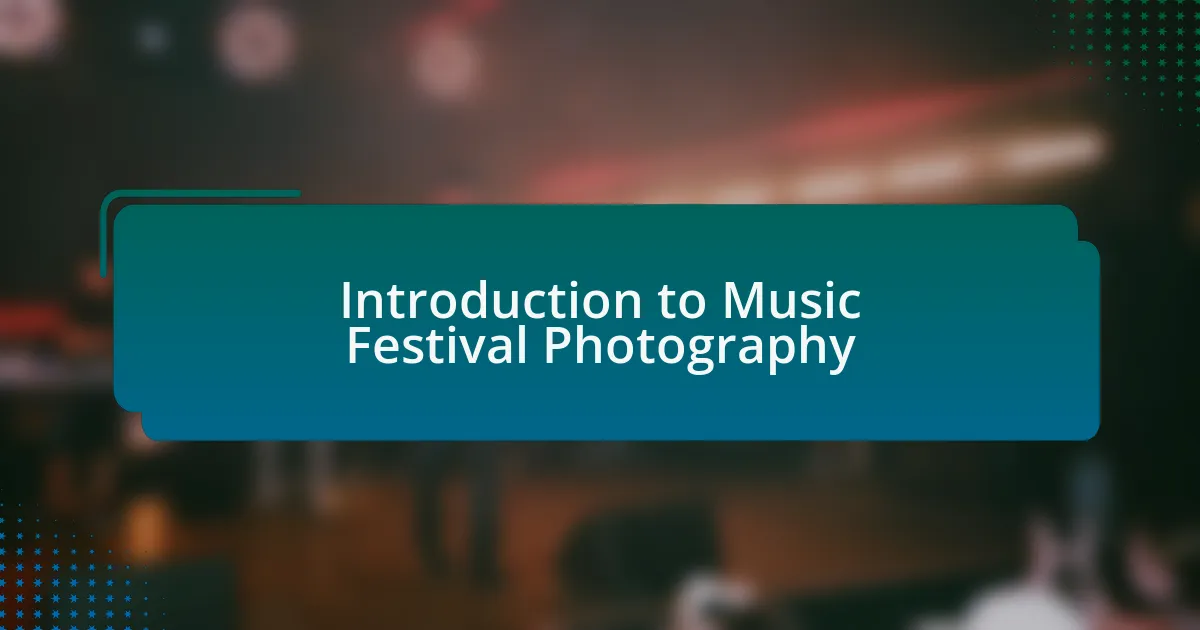
Introduction to Music Festival Photography
When I first stepped into a music festival as a photographer, I was overwhelmed by the electric atmosphere and vibrant energy around me. I remember being captivated by the way the stage lights danced against the crowd, creating a surreal backdrop that begged to be captured. Have you ever thought about how a single photo can convey the thrill of a live performance? It’s a challenge that requires both skill and intuition.
Festival photography is about more than just pointing and shooting; it’s about telling a story. Each festival has its unique vibe, from the eclectic outfits to the passionate fans, and I’ve learned that it’s essential to immerse myself fully in the scene. This personal connection often translates into more compelling images, as you’ve got to feel the emotions of the moment to truly capture them.
I’ve found that the best photographs often come from those spontaneous moments you didn’t plan for. Whether it’s a heartfelt interaction between friends or an artist sharing a genuine smile with the audience, these fleeting instances can create lasting memories. So, what’s your approach to catching those magic moments? Trust me, being present and responsive makes all the difference in creating a powerful narrative through your lens.
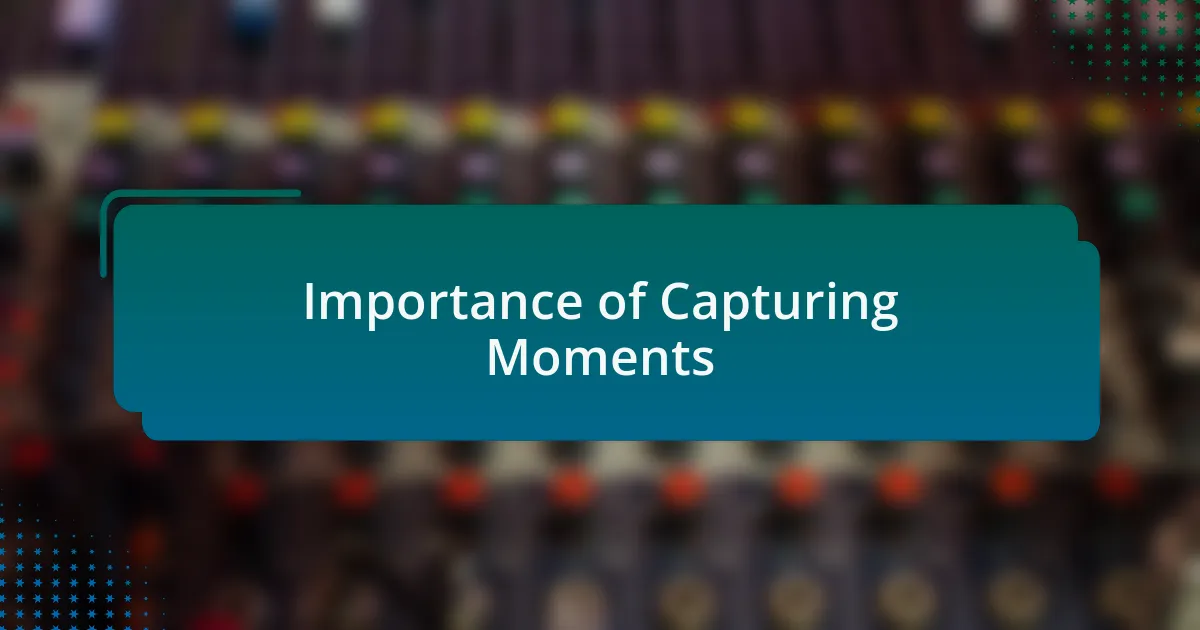
Importance of Capturing Moments
Capturing moments at a festival is vital because it freezes time, allowing us to relive the feelings associated with those experiences. I recall one particular moment at a small festival when the headliner paused during a powerful song, looking out at the crowd with a mix of gratitude and joy. In that instant, my heart raced, and I snapped a picture that perfectly encapsulated the connection between the artist and the audience. Can you imagine how that single image speaks volumes about the magic of live music?
Every photograph tells a deeper story, revealing emotions that might go unnoticed in the chaos of a festival. I remember photographing a group of friends, their faces lit up with anticipation just before their favorite band took the stage. Their excitement was contagious and made me realize that behind each face in the crowd is a unique story waiting to be shared. How often do we overlook the beauty of these shared moments while we’re lost in the music?
The importance of capturing moments extends beyond the individual; it helps document the collective experience of the festival. During a performance filled with euphoric highs and poignant lows, I’ve witnessed the entire crowd coming together, arms raised, swaying in harmony. Those images transcend just one person’s experience, embodying the spirit of the festival itself. Isn’t it incredible to think how a photo can reflect the unity and diversity of the crowd?
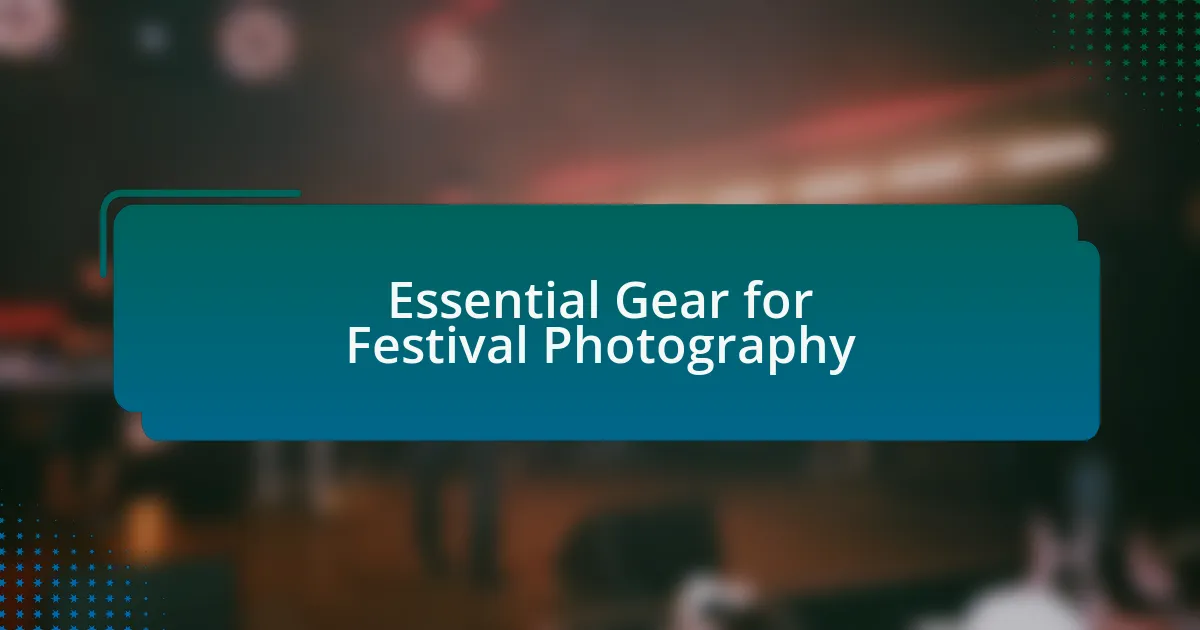
Essential Gear for Festival Photography
When it comes to festival photography, the right gear can make all the difference. I always recommend a versatile camera that can perform well in varying lighting conditions. A DSLR or mirrorless camera with good low-light performance is essential because, as I’ve experienced, those evening performances often bathe the crowd in mesmerizing lights that can be tricky to capture.
Lenses are another crucial component of your kit. A fast prime lens, like a 50mm f/1.8, can allow you to capture stunning portraits of festival-goers with beautiful background blur, even in dim lighting. I remember using my 24-70mm lens to seamlessly transition from wide-angle shots of expansive crowds to stunning close-ups of musicians, making me feel like I could tell multiple stories from a single spot.
Don’t underestimate the importance of accessories, either. A good pair of noise-canceling headphones to block out distractions while editing photos helps me focus on the creative process. And trust me, bringing extra batteries is non-negotiable; I’ve missed great moments simply because my camera died mid-set. Have you ever felt that sinking feeling when you realize you can’t capture a spontaneous moment? It’s a reminder that being prepared transforms not just your photographs, but your entire festival experience.
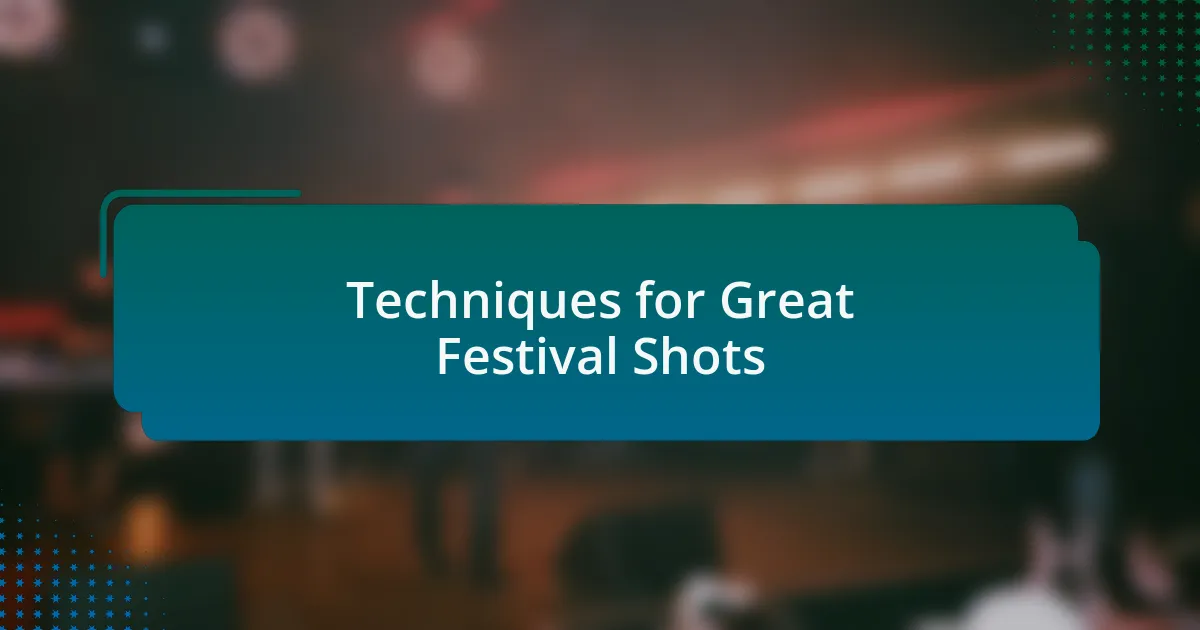
Techniques for Great Festival Shots
Capturing the essence of a music festival requires more than just having the right gear; it’s about mastering a few essential techniques. I often find that shooting from different angles can drastically change a photo’s impact. On one occasion, I crouched low to capture the ecstatic faces of fans, and the result was a striking image that conveyed pure joy. Have you ever tried this perspective? It adds depth and a unique touch to your festival shots.
Another technique I’ve embraced is utilizing burst mode, especially during high-energy performances. When the crowd is jumping and the artists are moving intensely, I’ve found that taking multiple shots in quick succession allows me to select the perfect moment later. It’s exhilarating to sift through those images and discover hidden gems that perfectly encapsulate the energy of the event. It’s like being a treasure hunter in a sea of excitement.
Lastly, I pay close attention to the lighting changes throughout the day. During golden hour, I often adjust my settings to harness that beautiful warm light, which can elevate a simple shot into something magical. I recall a beautiful sunset that perfectly framed a band on stage, and those photos became my favorites from the entire festival. Have you embraced different lighting conditions? It’s all about adapting and creating your own story through the lens.
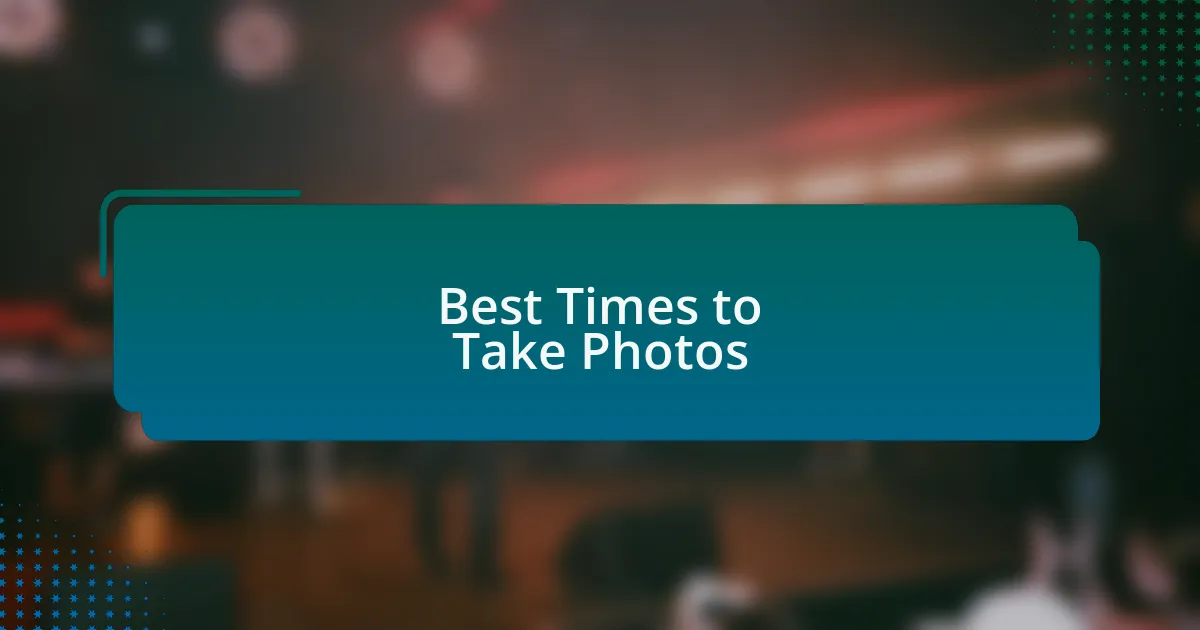
Best Times to Take Photos
When it comes to timing your shots, I’ve discovered that capturing moments during the performances can be particularly rewarding. The energy peaks when artists engage with the crowd, creating an electric atmosphere that translates beautifully in photographs. I remember snapping a photo of a lead singer reaching out to the audience, and the sheer exhilaration on the fans’ faces was unforgettable. Have you experienced that rush while shooting?
I also advise keeping an eye on the transitions between acts. The quiet moments just before the next performance can offer intimate glimpses into the anticipation of the crowd. I once captured a shot of a young girl holding a handmade sign, her eyes wide with excitement—it perfectly embodied the spirit of the festival. These quieter moments often provide a unique contrast to the frenetic energy of live performances and can tell a compelling story.
Finally, never overlook the late-night sets. Nighttime photography can be tricky; however, I’ve found that with the right settings, the vibrant lights of the stage create a stunning backdrop. One evening, I stood back to capture a mesmerizing light show that danced across the crowd—those photos felt almost magical. Isn’t it fascinating how the mood shifts as the day transitions into night? Embracing these different times truly enriches your festival photography experience.
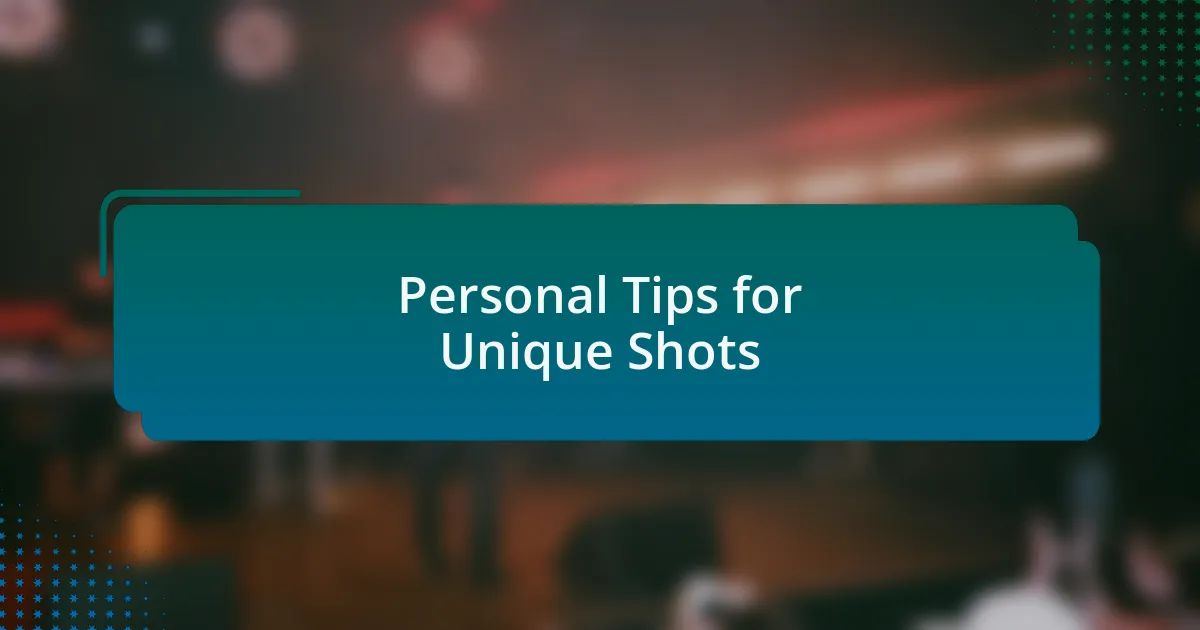
Personal Tips for Unique Shots
When shooting at a festival, I find that looking for unique angles can vastly improve the impact of your photos. One time, I decided to shoot from the side of the stage rather than front and center. The resulting images captured the performers in a more candid light, revealing their focus and passion—what a difference it made to the story they told! Have you ever considered how a simple shift in perspective can change the whole feel of your shot?
Another tip I swear by is to connect with the attendees during the festival. I experienced this firsthand when I approached a group of friends happily dancing together. I took a few candid shots as they laughed and cheered, and by sharing their joy, I felt I was part of their experience. Those images showcase the essence of the festival, don’t you think? It’s about capturing the spirit of community in such a vibrant setting.
Lastly, I believe incorporating elements of the festival itself into your shots can create a more immersive image. During one festival, I started framing my subjects against iconic decorations—like colorful banners and art installations. It added a layer of depth and context to my photos that would not have been possible otherwise. Have you experimented with this approach? I think it allows viewers to really feel the atmosphere, making them feel as if they were there with you.
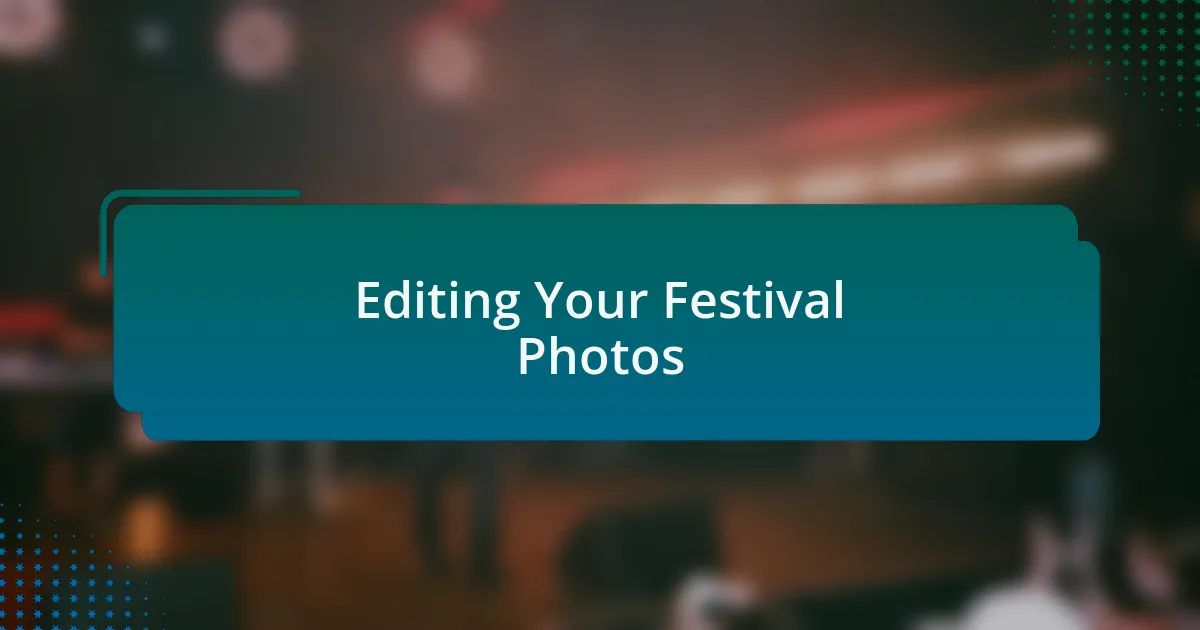
Editing Your Festival Photos
When it comes to editing your festival photos, I always suggest starting with the basics: cropping and exposure adjustments. Recently, while editing shots from an outdoor festival, I discovered that simply cropping out distractions made my subject stand out more. It was like peeling back layers to reveal the essence of the moment—don’t you love how a straightforward edit can transform an image?
Next, I often play around with color correction to enhance the festival’s vibrancy. During one particularly colorful event, I realized that slightly adjusting the saturation made the atmosphere pop, as if bringing the festival back to life. Have you tried this before? Just think about how a vivid palette can evoke the energy and excitement of those unforgettable performances!
Lastly, I really enjoy adding a bit of contrast to give depth to my images. I recall editing a night-time shot of a dazzling light display; they looked stunning against the dark sky. By increasing the contrast a little, the colors blended beautifully, creating a mesmerizing effect. What editing techniques have you found enhance your own festival photography? Sharing these insights can be incredibly rewarding and can lead to even more captivating images!